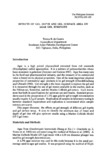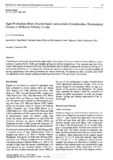Effects of gel depth and gel surface area on agar gel strength
- Global styles
- MLA
- Vancouver
- Elsevier - Harvard
- APA
- Help

View/
Date
1993Author
Page views
2,585ASFA keyword
AGROVOC keyword
Metadata
Show full item record
Share
Abstract
Agar is a high priced phycocolloid extracted from red seaweeds (Rhodophyta) called agarophytes. It is a mixture of polysaccharides whose basic monomer is galactose (Armisen and Galatas 1987). Agar has many uses in the food and pharmaceutical industry, and the measure of its commercial value is based on its physical properties. One of the most important physical properties of commercial agar products is its gel strength (Chandrkrachang and Chinadit 1988). Gel strength is the force required to rupture the gel and it is measured through the use of gel testers available in the market, such as the Nikkan-sui, Rowerbal, and the Marine Colloids gel testers. Each instrument has built-in specifications for optimum use and results. Standard procedures used in the preparation of 1.5% agar gels for gel strength determination usually require 1.5 g of sample. Replication of samples in laboratory testing is however standard requirement and replication is constrained when sample extracts are scarce.
This paper discusses the effects on gel strength of different gel depths and gel surface areas. It aims to identify the minimum size of vessel and depth of gel that will give optimum results using a Marine Colloids Model GT-2 gel tester.
Suggested Citation
de Castro, T. R. (1993). Effects of gel depth and gel surface area on agar gel strength. The Philippine Scientist , 30, 100-103. http://hdl.handle.net/10862/1411
Type
ArticleISSN
0079-1466Collections
- Journal Articles [1229]
Related items
Showing items related by title, author, creator and subject.
-
Agar yield and gel strength of Gracilaria heteroclada collected from Iloilo, Central Philippines
Luhan, Maria Rovilla J. (Walter de Gruyter, 1992)Seasonality of yield and gel strength of agar from Gracilaria heteroclada was determined. Gel strength was high (510-794 gm cm-2) during early dry season (October-March) and low (43-101 gm cm-2) during ... -
Agar production from Gracilariopsis heteroclada (Gracilariales, Rhodophyta) grown at different salinity levels
Hurtado-Ponce, A. Q. (Walter de Gruyter, 1994)Gracilariopsis heteroclada grown in fiber glass tanks at four salinity levels was treated with three different concentrations of aqueous NaOH. Yield, gel strength, gelling and melting temperatures of the extracted agar ... -
Influence of extraction time on the rheological properties of agar from some Gracilaria species from the Philippines
Hurtado-Ponce, Anicia Q. (Walter de Gruyter, 1992)The influence of extraction time on the clean anhydrous yield, rheological properties, dynamic gelling and melting temperatures of 1.5% agar from six species of Gracilaria and one species of Gracilariopsis collected from ...




